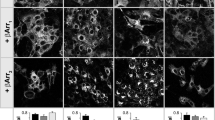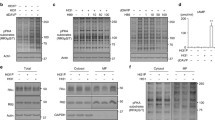Abstract
Nephrogenic syndrome of inappropriate antidiuresis (NSIAD) is a recently identified chromosome X-linked disease associated with gain-of-function mutations of the V2 vasopressin receptor (V2R), a G-protein-coupled receptor. It is characterized by inability to excrete a free water load, hyponatremia, and undetectable vasopressin-circulating levels. Hyponatremia can be quite severe in affected male children. To gain a deeper insight into the functional properties of the V2R active mutants and how they might translate into the pathological outcome of NSIAD, in this study, we have expressed the wild-type V2R and three constitutively active V2R mutants associated with NSIAD (R137L, R137C, and the F229V) in MCD4 cells, a cell line derived from renal mouse collecting duct, stably expressing the vasopressin-sensitive water channel aquaporin-2 (AQP2). Our findings indicate that in cells expressing each active mutant, AQP2 was constitutively localized to the apical plasma membrane in the absence of vasopressin stimulation. In line with these observations, under basal conditions, osmotic water permeability in cells expressing the constitutively active mutants was significantly higher compared to that of cells expressing the wild-type V2R. Our findings demonstrate a direct link between activating mutations of the V2R and the perturbation of water balance in NSIAD. In addition, this study provides a useful cell-based assay system to assess the functional consequences of newly discovered activating mutations of the V2R on water permeability in kidney cells and to screen the effect of drugs on the mutated receptors.







Similar content being viewed by others
References
Birnbaumer M (2000) Vasopressin receptors. Trends Endocrinol Metab 11:406–410
Bouley R, Hasler U, Lu HA, Nunes P, Brown D (2008) Bypassing vasopressin receptor signaling pathways in nephrogenic diabetes insipidus. Semin Nephrol 28:266–278. https://doi.org/10.1016/j.semnephrol.2008.03.010
Boone M, Deen PM (2008) Physiology and pathophysiology of the vasopressin-regulated renal water reabsorption. Pflugers Arch 456:1005–1024. https://doi.org/10.1007/s00424-008-0498-1
Olesen ET, Moeller HB, Assentoft M, MacAulay N, Fenton RA (2016) The vasopressin type 2 receptor and prostaglandin receptors EP2 and EP4 can increase aquaporin-2 plasma membrane targeting through a cAMP-independent pathway. Am J Physiol Renal Physiol 311:F935–F944. https://doi.org/10.1152/ajprenal.00559.2015
Tamma G, Lasorsa D, Trimpert C, Ranieri M, Di Mise A, Mola MG, Mastrofrancesco L, Devuyst O, Svelto M, Deen PM, Valenti G (2014) A protein kinase A-independent pathway controlling aquaporin 2 trafficking as a possible cause for the syndrome of inappropriate antidiuresis associated with polycystic kidney disease 1 haploinsufficiency. J Am Soc Nephrol 25:2241–2253. https://doi.org/10.1681/asn.2013111234
Bichet DG (2006) Diabètes insipides néphrogéniques (Nephrogenic diabetes insipidus). Nephrol Ther 2:387–404. https://doi.org/10.1016/j.nephro.2006.07.010
Morello JP, Bichet DG (2001) Nephrogenic diabetes insipidus. Annu Rev Physiol 63:607–630. https://doi.org/10.1146/annurev.physiol.63.1.607
Ranieri M, Di Mise A, Tamma G, Valenti G (2019) Vasopressin-aquaporin-2 pathway: recent advances in understanding water balance disorders. F1000Research 8:8. https://doi.org/10.12688/f1000research.16654.1
Feldman BJ, Rosenthal SM, Vargas GA, Fenwick RG, Huang EA, Matsuda-Abedini M, Lustig RH, Mathias RS, Portale AA, Miller WL, Gitelman SE (2005) Nephrogenic syndrome of inappropriate antidiuresis. N Engl J Med 352:1884–1890. https://doi.org/10.1056/NEJMoa042743
Bartter FC, Schwartz WB (1967) The syndrome of inappropriate secretion of antidiuretic hormone. Am J Med 42:790–806
Rosenthal W, Seibold A, Antaramian A, Gilbert S, Birnbaumer M, Bichet DG, Arthus MF, Lonergan M (1994) Mutations in the vasopressin V2 receptor gene in families with nephrogenic diabetes insipidus and functional expression of the Q-2 mutant. Cell Mol Biol (Noisy-le-Grand) 40:429–436
Carpentier E, Greenbaum LA, Rochdi D, Abrol R, Goddard WA 3rd, Bichet DG, Bouvier M (2012) Identification and characterization of an activating F229V substitution in the V2 vasopressin receptor in an infant with NSIAD. J Am Soc Nephrol 23:1635–1640. https://doi.org/10.1681/asn.2012010077
Erdelyi LS, Mann WA, Morris-Rosendahl DJ, Gross U, Nagel M, Varnai P, Balla A, Hunyady L (2015) Mutation in the V2 vasopressin receptor gene, AVPR2, causes nephrogenic syndrome of inappropriate diuresis. Kidney Int 88:1070–1078. https://doi.org/10.1038/ki.2015.181
Tiulpakov A, White CW, Abhayawardana RS, See HB, Chan AS, Seeber RM, Heng JI, Dedov I, Pavlos NJ, Pfleger KD (2016) Mutations of vasopressin receptor 2 including novel L312S have differential effects on trafficking. Mol Endocrinol 30:889–904. https://doi.org/10.1210/me.2016-1002
Decaux G, Vandergheynst F, Bouko Y, Parma J, Vassart G, Vilain C (2007) Nephrogenic syndrome of inappropriate antidiuresis in adults: high phenotypic variability in men and women from a large pedigree. J Am Soc Nephrol 18:606–612. https://doi.org/10.1681/asn.2006090987
Rochdi MD, Vargas GA, Carpentier E, Oligny-Longpre G, Chen S, Kovoor A, Gitelman SE, Rosenthal SM, von Zastrow M, Bouvier M (2010) Functional characterization of vasopressin type 2 receptor substitutions (R137H/C/L) leading to nephrogenic diabetes insipidus and nephrogenic syndrome of inappropriate antidiuresis: implications for treatments. Mol Pharmacol 77:836–845. https://doi.org/10.1124/mol.109.061804
Tenenbaum J, Ayoub MA, Perkovska S, Adra-Delenne AL, Mendre C, Ranchin B, Bricca G, Geelen G, Mouillac B, Durroux T, Morin D (2009) The constitutively active V2 receptor mutants conferring NSIAD are weakly sensitive to agonist and antagonist regulation. PLoS One 4:e8383. https://doi.org/10.1371/journal.pone.0008383
Kocan M, See HB, Sampaio NG, Eidne KA, Feldman BJ, Pfleger KD (2009) Agonist-independent interactions between beta-arrestins and mutant vasopressin type II receptors associated with nephrogenic syndrome of inappropriate antidiuresis. Mol. Endocrinol (Baltimore, Md) 23:559–571. https://doi.org/10.1210/me.2008-0321
Iolascon A, Aglio V, Tamma G, D'Apolito M, Addabbo F, Procino G, Simonetti MC, Montini G, Gesualdo L, Debler EW, Svelto M, Valenti G (2007) Characterization of two novel missense mutations in the AQP2 gene causing nephrogenic diabetes insipidus. Nephron Physiol 105:p33–p41. https://doi.org/10.1159/000098136
Jung HJ, Kwon TH (2016) Molecular mechanisms regulating aquaporin-2 in kidney collecting duct. Am J Physiol Renal Physiol 311:F1318–F1328. https://doi.org/10.1152/ajprenal.00485.2016
Kwon TH, Frokiaer J, Nielsen S (2013) Regulation of aquaporin-2 in the kidney: a molecular mechanism of body-water homeostasis. Kidney Res Clinic Pract 32:96–102. https://doi.org/10.1016/j.krcp.2013.07.005
Nedvetsky PI, Tamma G, Beulshausen S, Valenti G, Rosenthal W, Klussmann E (2009) Regulation of aquaporin-2 trafficking. Handb Exp Pharmacol:133–157. https://doi.org/10.1007/978-3-540-79885-9_6
Noda Y, Sasaki S (2006) Regulation of aquaporin-2 trafficking and its binding protein complex. Biochim Biophys Acta 1758:1117–1125. https://doi.org/10.1016/j.bbamem.2006.03.004
Valenti G, Procino G, Tamma G, Carmosino M, Svelto M (2005) Minireview: Aquaporin 2 trafficking. Endocrinology 146:5063–5070. https://doi.org/10.1210/en.2005-0868
Ando F, Sohara E, Morimoto T, Yui N, Nomura N, Kikuchi E, Takahashi D, Mori T, Vandewalle A, Rai T, Sasaki S, Kondo Y, Uchida S (2016) Wnt5a induces renal AQP2 expression by activating calcineurin signalling pathway. Nat Commun 7:13636. https://doi.org/10.1038/ncomms13636
Cheung PW, Terlouw A, Janssen SA, Brown D, Bouley R (2019) Inhibition of non-receptor tyrosine kinase Src induces phosphoserine 256-independent aquaporin-2 membrane accumulation. J Physiol 597:1627–1642. https://doi.org/10.1113/jp277024
Olesen ET, Fenton RA (2017) Aquaporin-2 membrane targeting: still a conundrum. Am J Physiol Renal Physiol 312:F744–F747. https://doi.org/10.1152/ajprenal.00010.2017
Barak LS, Oakley RH, Laporte SA, Caron MG (2001) Constitutive arrestin-mediated desensitization of a human vasopressin receptor mutant associated with nephrogenic diabetes insipidus. Proc Natl Acad Sci U S A 98:93–98. https://doi.org/10.1073/pnas.011303698
Costa T, Cotecchia S (2005) Historical review: negative efficacy and the constitutive activity of G-protein-coupled receptors. Trends Pharmacol Sci 26:618–624. https://doi.org/10.1016/j.tips.2005.10.009
Scheer A, Costa T, Fanelli F, De Benedetti PG, Mhaouty-Kodja S, Abuin L, Nenniger-Tosato M, Cotecchia S (2000) Mutational analysis of the highly conserved arginine within the Glu/Asp-Arg-Tyr motif of the alpha(1b)-adrenergic receptor: effects on receptor isomerization and activation. Mol Pharmacol 57:219–231
Steinberg EA, Moss M, Buchanan CL, Goebel J (2018) Adherence in pediatric kidney transplant recipients: solutions for the system. Pediatr Nephrol 33:361–372. https://doi.org/10.1007/s00467-017-3637-0
Tamma G, Procino G, Strafino A, Bononi E, Meyer G, Paulmichl M, Formoso V, Svelto M, Valenti G (2007) Hypotonicity induces aquaporin-2 internalization and cytosol-to-membrane translocation of ICln in renal cells. Endocrinology 148:1118–1130. https://doi.org/10.1210/en.2006-1277
Procino G, Barbieri C, Tamma G, De Benedictis L, Pessin JE, Svelto M, Valenti G (2008) AQP2 exocytosis in the renal collecting duct—involvement of SNARE isoforms and the regulatory role of Munc18b. J Cell Sci 121:2097–2106. https://doi.org/10.1242/jcs.022210
Ranieri M, Tamma G, Di Mise A, Russo A, Centrone M, Svelto M, Calamita G, Valenti G (2015) Negative feedback from CaSR signaling to aquaporin-2 sensitizes vasopressin to extracellular Ca2. J Cell Sci 128:2350–2360. https://doi.org/10.1242/jcs.168096
Acknowledgments
We are grateful to Dr. Paola Molinari (Istituto Superiore di Sanità, Rome) for her advice in signal transduction experiments and Prof. Francesca Fanelli (University of Modena-Reggio Emilia) for helpful discussions. We thank Prof. Michel Bouvier (University of Montreal, Canada) for providing the cDNA of the V2 receptors.
Funding
The financial support of Telethon - Italy (Grant Number GGP13227) is gratefully acknowledged. Marianna Ranieri is a postdoctoral research fellow supported by “Intervento cofinanziato dal Fondo di Sviluppo e Coesione 2007-2013–APQ Ricerca Regione Puglia, Programma Regionale a Sostegno della Specializzazione Intelligente e della Sostenibilità Sociale ed Ambientale–FutureInResearch.”
Author information
Authors and Affiliations
Corresponding authors
Ethics declarations
Conflict of interest
The authors declare that they have no conflict of interest.
Additional information
Publisher’s note
Springer Nature remains neutral with regard to jurisdictional claims in published maps and institutional affiliations.
Rights and permissions
About this article
Cite this article
Ranieri, M., Tamma, G., Pellegrino, T. et al. Gain-of-function mutations of the V2 vasopressin receptor in nephrogenic syndrome of inappropriate antidiuresis (NSIAD): a cell-based assay to assess constitutive water reabsorption. Pflugers Arch - Eur J Physiol 471, 1291–1304 (2019). https://doi.org/10.1007/s00424-019-02307-x
Received:
Revised:
Accepted:
Published:
Issue Date:
DOI: https://doi.org/10.1007/s00424-019-02307-x




